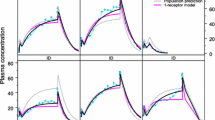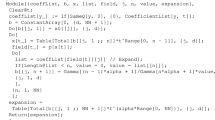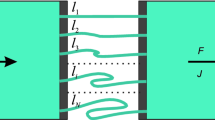Abstract
The concentration of a drug in the circulatory system is studied under two different elimination strategies. The first strategy—geometric elimination—is the classical one which assumes a constant elimination rate per cycle. The second strategy—Poisson elimination—assumes that the elimination rate changes during the process of elimination. The problem studied here is to find a relationship between the residence-time distribution and the cycle-time distribution for a given rule of elimination. While the presented model gives this relationship in terms of Laplace-Stieltjes transform, the aim here is to determine the shapes of the corresponding probability density functions. From experimental data, we expect positively skewed, gamma-like distributions for the residence time of the drug in the body. Also, as some elimination parameter in the model approaches a limit, the exponential distribution often arises. Therefore, we use laguerre series expansions, which yield a parsimonious approximation of positively skewed probability densities that are close to a gamma distribution. The coefficients in the expansion are determined by the central moments, which can be obtained from experimental data or as a consequence of theoretical assumptions. The examples presented show that gamma-like densities arise for a diverse set of cycle-time distributions and under both elimination rules.
Similar content being viewed by others
References
Beckman, J. A. 1974.Two Stochastic Processes. Stockholm: Almqvist and Wiksell.
Bowers, N. L. Jr. 1966. Expansion of probability density functions as a sum of gamma densities with applications in risk theory.Trans. Soc. Actuaries 18, 125–137.
Chhikara, R. S. and J. L. Folks 1989.The Inverse Gaussian Distribution. New York: Dekker.
Ďurišová, M., L. Dedík and M. Balan. 1995. Building a structured model of a complex pharmacokinetic system with time delays.Bull. Math. Biol. 57, 787–808.
Feller, W. 1966.An Introduction to Probability Theory and Its Applications. Vol. 2. New York: Wiley.
Johnson, N. L. and S. Kotz. 1970.Continuous Univariate Distributions. Vol. 1. New York: Wiley.
Lánský, P. 1996. A stochastic model for circulatory transport in pharmacokinetics.Math. Biosci. 132, 141–167.
Mari, A. 1993. Circulatory models of intact-body kinetics and their relationship with compartmental and noncompartmental analysis.J. Theor. Biol. 160, 509–531.
Mari, A. 1995. Determination of the single-pass impulse response of the body tissue with circulatory models.IEEE Trans. Biomed. Engrg. 42, 304–312.
Sheppard, C. W. 1971. Stochastic models for tracer experiments in the circulation. III. The lumped catenary system.J. Theor. Biol. 33, 491–515.
Smith, C. E. 1991. A laguerre series approximation for the probability density of the first passage time of the Ornstein-Uhlenbeck process. InNoise in Physical Systems and 1/f Fluctuations, T. Musha, S. Sato and M. Yamamoto (Eds). Tokyo: Ohmsha.
Tiku, M. L., W. Y. Tan and Y. Balakrishnan. 1986.Robust Inference. New York: Dekker.
van Rossum, J. M., J. G. M. de Bie, G. van Lingen and H. W. A. Teeuwen. 1989. Pharmacokinetics from a dynamical system point of view.J. Pharmacokin. Biopharm. 17, 365–397.
Waterhouse, C. and J. Keilson. 1972. Transfer times across the human body.Bull. Math. Biophys. 34, 33–44.
Weiss, M. 1982. Moments of physiological transit times distributions and the time course of drug disposition in the body.J. Math. Biol. 15, 305–318.
Weiss, M. 1984. A note on the role of generalized inverse Gaussian distribution of circulatory transit times in pharmacokinetics.J. Math. Biol. 20, 95–102.
Weiss, M. 1986. Generalizations in linear pharmacokinetics using properties of certain classes of residence time distributions. I. Log-convex drug disposition curve.J. Pharmacokin. Biopharm. 14, 635–657.
Weiss, M. 1991. Residence time distributions in pharmacokinetics: behavioral and structural models. InAdvanced Methods of Pharmacokinetics and Pharmacodynamics System Analysis, D. Z. D'Argenio (Ed). New York: Plenum Press.
Wise, M. E. 1985. Negative power functions of time in pharmacokinetics and their implications.J. Pharmacokin. Biopharm. 13, 309–346.
Wise, M. E. and G. J. J. M. Borsboom. 1989. Two exceptional sets of physiological clearance curves and their mathematical form: test cases?Bull. Math. Biol. 51, 579–596.
Author information
Authors and Affiliations
Rights and permissions
About this article
Cite this article
Smith, C.E., Lánsky, P. & Lung, TH. Cycle-time and residence-time density approximations in a stochastic model for circulatory transport. Bltn Mathcal Biology 59, 1–22 (1997). https://doi.org/10.1007/BF02459468
Received:
Accepted:
Issue Date:
DOI: https://doi.org/10.1007/BF02459468




